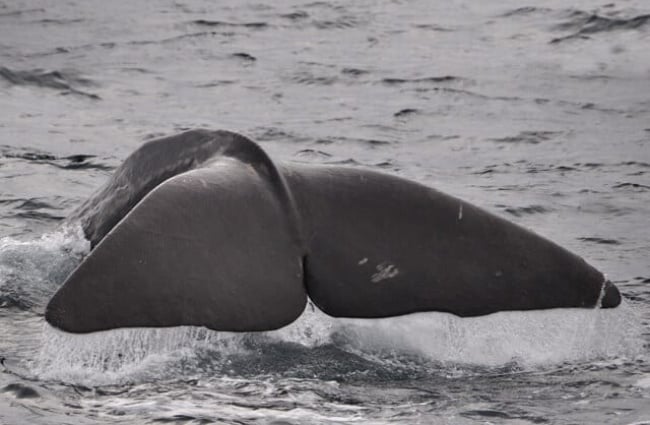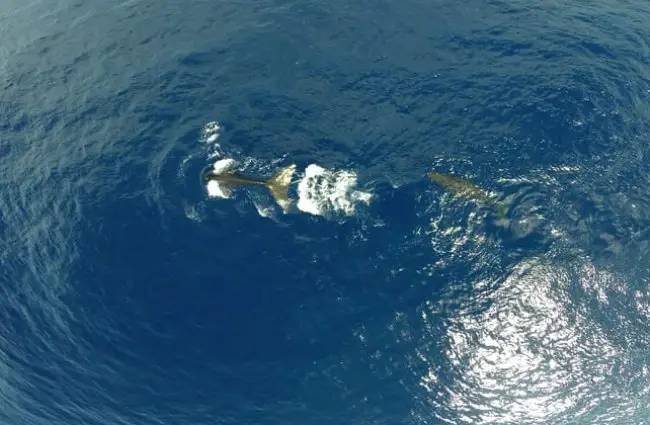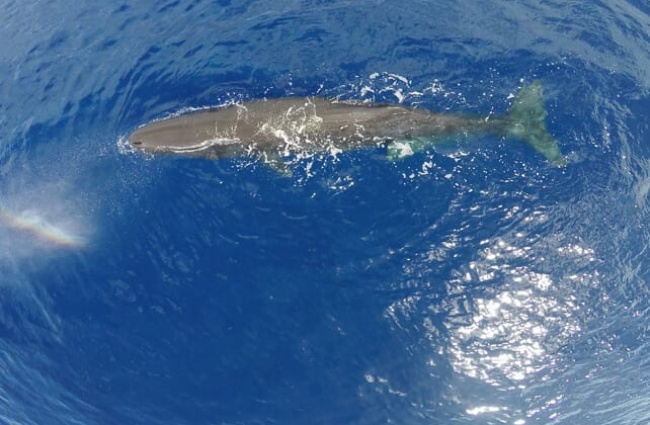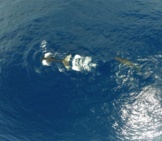The sperm whale has many distinctive characteristics that differ from the other notable whale species. In fact, the sperm whale is actually in an entirely different family than the other popular whale species. This unique animal is the largest of the toothed whales, and its day-to-day life will simply captivate you. Read on to learn about the sperm whale.
Description of the Sperm Whale
The sperm whale is a large, dark grey marine mammal with a pseudo-torpedo shaped body. The sperm whale’s mouth lies directly under it’s large forehead, which is called a “melon,” and the entire head is rather oblong in shape. Essentially, the sperm whale looks like a severed thumb that grew a tail at the end.
Interesting Facts About the Sperm Whale
The sperm whale is a rather odd-shaped animal, with an equally odd history. The sperm whale’s general behavior is also interesting, because its habits differ greatly from the “typical” whale.
- What’s in a Name – Possibly the most notable thing when discussing sperm whales is the animal’s name. There is some assumption that the sperm whale is named for it’s rather phallic shape, but this is actually incorrect. During the whaling era, sperm whales were hunted heavily via harpoon. When a sperm whale was speared in the head, the harpoon would frequently pierce the spermaceti organ, which produced thick oil that would ooze from the wound. Because this oil was milky white in appearance, whalers incorrectly assumed that the substance was the whale’s semen – hence the name sperm whale.
- Sleeping Whales – Most cetaceans (dolphins and whales) sleep with half their brains, so that they can continue to breathe. Consequentially, whales must float at the surface while they half-sleep, so that they don’t drown. Sperm whales are the exception to this rule, sleeping fully for very short periods of time. It is believed the sperm whale sleeps only about 15 minutes at a time. While napping, sperm whales drift vertically, with their heads facing the surface and their tails pointed down.
- Battle of the Giants – Sperm whales descend to the depths of the oceans to feed, and are known to dive between 980 – 6,600 feet deep. While at these depths, sperm whales hunt and battle the mysterious giant squid. No human has never witnessed this battle, but the sperm whale’s skin bears unmistakable circular scars from the giant squid’s suckers.
Habitat of the Sperm Whale
The sperm whale prefers habitats that are free from ice, and inhabits depths of 3,300 feet on average, surfacing to breathe and sleep. They can be found frequently near underwater canyons, and the edges of continental shelves.
Distribution of the Sperm Whale
The sperm whale can be found in tropical and temperate oceans, and adult males are sometimes found at higher latitudes. They are found in virtually every ocean from the north to south pole, but tend to remain in deep waters offshore in temperate and tropical seas.
Diet of the Sperm Whale
The sperm whale feeds on a number of different species of squid, including the giant squid and the colossal squid. They mainly eat medium-sized squid, but will feed on octopus, stingrays, and other deep-sea fish.
Sperm Whale and Human Interaction
Similar to their effect on other species, humans have had an immensely negative impact on the sperm whale. In the case of the sperm whale, the human interaction was in the name of whale oil acquisition. The sperm whale’s head contains an oil called “spermaceti,” which is produced in the conveniently named spermaceti organ.
The whales were also coveted for the rare ambergris they occasionally generate to coat squid beaks that cannot be digested. This foul-smelling substance was surprisingly used in expensive perfume production before being outlawed in many countries.
Domestication
The domestication of sperm whales would be impractical, because of their large size and hunting habits. Providing a habitat deep enough for this animal would be virtually impossible.
Does the Sperm Whale Make a Good Pet
The sperm whale would not make a good pet, and keeping a sperm whale in human care for long periods of time is simply not possible. Not only does this gigantic animal require immense space to thrive, the amount of food necessary to keep the whale alive is staggering.
Sperm Whale Care
To care for a sperm whale properly, it would have to be provided with a proper diet of medium to large squid, and given the ability to dive a couple thousand feet.
Behavior of the Sperm Whale
Sperm whales hunt their prey at immense depths. They dive to a few thousand feet deep, and flip upside down to hunt squid from below. Other predators, notably great white sharks, also employ this tactic.
Female and young sperm whales live and travel together in pods, which allows them to use an interesting tactic to protect their young from other predators. The whales of the pod will surround the threatened individual, using their massive bodies to form a barrier.
Reproduction of the Sperm Whale
Male sperm whales typically only interact with other members of their species when they are breeding. They will occasionally form small bachelor pods, but do not generally live with the pods of females and their young. When breeding, the males will battle each other, and the dominant animal will mate with multiple females.
The Tale of Moby Dick
The sperm whale may be most famous as the antagonist in the novel Moby Dick by Herman Melville. This novel was based on the story of the whaling ship, the Essex, which was purportedly sunk by a sperm whale ramming the vessel. There are actually a number of accounts during the whaling era of sperm whales striking ships, but they have been mostly shrugged off as fanciful dramatizations.
While it most certainly is not a common occurrence, researchers believe that sperm whales do have the physical capability to sink a ship. The spermaceti organ and surrounding area provides cushioning for the whale’s head, preventing skull fractures in the event of a collision. In reality, it is entirely possible for the sperm whale to sink a ship.







![Red Angus Closeup of a beautiful Red Angus cowPhoto by: U.S. Department of Agriculture [pubic domain]https://creativecommons.org/licenses/by/2.0/](https://animals.net/wp-content/uploads/2020/03/Red-Angus-4-238x178.jpg)












![Red Angus Closeup of a beautiful Red Angus cowPhoto by: U.S. Department of Agriculture [pubic domain]https://creativecommons.org/licenses/by/2.0/](https://animals.net/wp-content/uploads/2020/03/Red-Angus-4-100x75.jpg)

